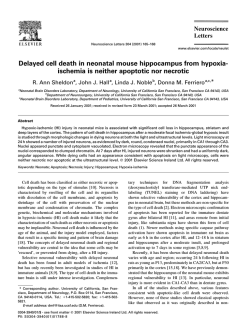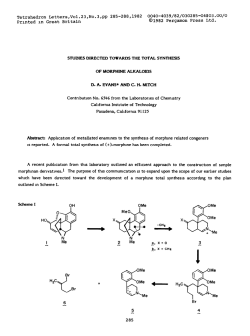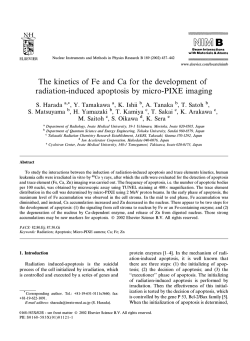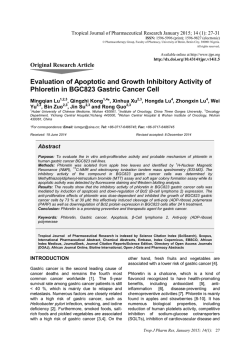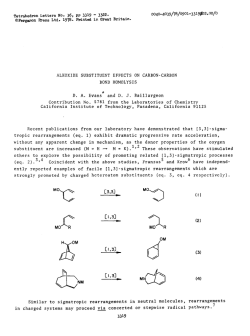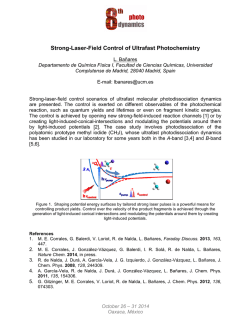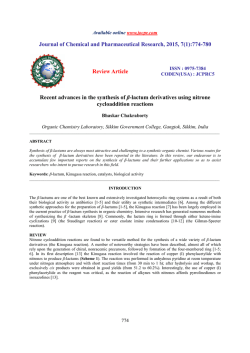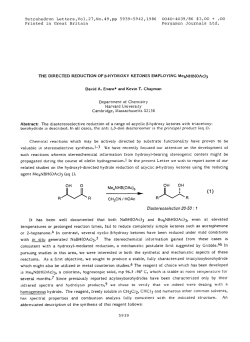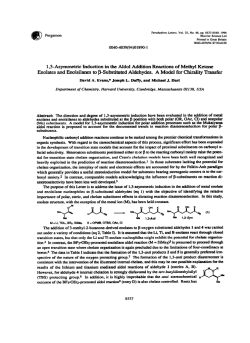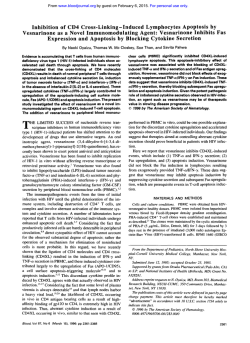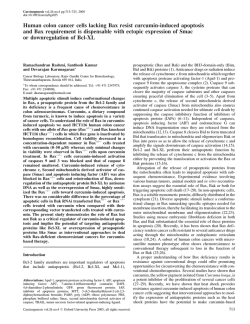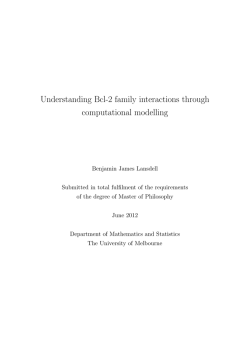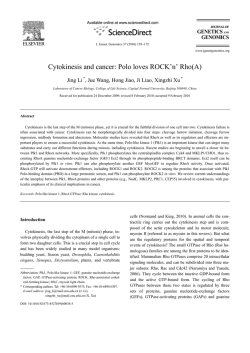
111 REFERENCES 1. Ray, A., “Cancer preventive
111 REFERENCES 1. Ray, A., “Cancer preventive role of selected dietary factors,” Ind J Cancer., 42(1), pp.15-24, 2005. 2. Abercrombie, M., and Ambrose, E.J., “The Surface Properties of Cancer Cells: A Review,” Cancer Res., 22, pp. 525-548, 1962. 3. Eisenhauer, E. A., Therasse, P., Bogaert, J., Schwartz, L.H., Sargent, D., Ford, R,J., Dancey, S., Arbuck, S., Gwyther, M., Mooney, L., Rubinstein, L., Shankar, L., Dodd, R., Kaplan, D., Lacombe, J., Verweij., A., “ New response evaluation criteria in solid tumours:Revised RECIST guideline,” European Journal of Cancer.,45, pp. 228–247, 2009. 4. Anand, P., Kunnumakara, A. B., Sundaram, C., Harikumar, K. B., Tharakan, T. S., Lai, O. S., Sung, O., and Aggarwal, B. B., “Cancer is a Preventable Disease that Requires Major Lifestyle Changes,” Pharm Res., 25(9), pp. 2097–2116, 2008. 5. Aikins, A. G., Boynton, P., and Atanga. L. L., “Developing effective chronic disease interventions in Africa: insights from Ghana and Cameroon,” Globalization and Health., 6(6), 2010. 6. Jemal, A., Center, M. M., DeSantis, C., and Ward, E.M.,“ Global Patterns of Cancer Incidence and Mortality Rates and Trends,” Cancer Epidemiol Biomarkers Prev.,19, pp. 1893-1907, 2010. 7. Ferlay, J., Shin, H.R., Bray, F., Forman, D., Mathers, C., Parkin, D.M., “Estimates of worldwide burden of cancer in 2008: GLOBOCAN 2008,” Int J Cancer., 27(12), pp 2893-2917, 2010. 8. Ridge, J, A., Glisson, B. S., Lango, M. N., “Head and Neck Tumors" in Pazdur, R, Wagman, L.D, Camphausen, K.A, Hoskins, W.J., (Eds) Cancer Management: A Multidisciplinary Approach. 11 ed. 2008. 9. Latifi, H., Mikaili, P., Latifi, K., Torbati, H., “Squamous cell carcinoma of larynx in northwestern Iran.” European Journal of Experimental Biology, 2 (1), pp. 242246, 2012. 10. Daly, M. E., Le, Q. T., Jain, A. K, Maxim, P. G., Hsu, A., Loo, B. W. Jr, Kaplan, M. J., Fischbein, N. J., Colevas, A. D., Pinto, H., Chang, D.T., “Intensitymodulated radiotherapy for locally advanced cancers of the larynx and hypopharynx,” Head Neck .,33, pp. 103-111, 2011. 112 11. Chadha, S., Gupta, B., Jatwani, S., Gulati, A., “A study of patient factors and tumor characteristics in malignancy of larynx: A tertiary care center experience,” Journal of Laryngol Voice., 1, pp. 79-80, 2011. 12. Ali, I., Wani, W. A., and Saleem, K., “Cancer Scenario in India with Future Perspectives,” Cancer Therapy, 9, pp. 56-70, 2011. 13. Cordero, M., Borbón, H., Román, F. R., Víquez, R., Villegas, L.R., Soto, R., Vega, I., and Herrera, J. M., “Antimicrobial Activity and Phytochemical Screening of Secondary Metabolites Extracted from the Ascidian rhopalaea Birkelandi, “ European Journal of Scientific Research, 70(3), pp.345-353,2012. 14. Geoffrey A. Cordell., “ Pharmacognosy A High tech Pharmaceutical Science,” Pharmacia JTPA, 30(3), pp. 169-181,1990. 15. Wilkinson, E. J., and Teixeira, M. R., “Epithelial tumours, squamous tumours,” in World Health Organisation, Classification of Tumours: Pathology and Genetics: Tumours of the Breast and Female Genital Organs,” 270, pp. 316–320, IARC Press Lyon, France, 2003. 16. Boivin, D., Lamy, S., Dufour, S. L., Jackson, J., Beaulieu, E., Cotec, M., Moghrabi, A., Barrette, S., Gingras, D., Béliveau, R.,” Antiproliferative and antioxidant activities of common vegetables: A comparative study,” Food Chemistry, 112, pp. 374–380, 2009. 17. Farag, M. A., and Motaal, A. A., “Sulforaphane composition, cytotoxic and antioxidant activity of crucifer vegetables,” Journal of Advanced Research, 1, pp. 65–70, 2010. 18. Thornalley, P. J., “Isothiocyanates: mechanism of cancer chemopreventive Action,” Anti Cancer Drugs, 13, pp. 331–338, 2002. 19. Devi, P. U., Akagi, K., Ostapenko, V., Tanaka, Y., Sugahara, T., “Withaferin A: a new radiosensitizer from the Indian medicinal plant Withania somnifera,” Int J Radiat Biol, 69, pp. 193-197,1996. 20. Verhoeven, D. T. H., Verhagen, H., Goldbohm, R. A., Brandtb, P. A., Poppel, G. A., “ A review of mechanisms underlying anticarcinogenicity by brassica vegetables,” Chemico-Biological Interactions., 103, pp 79- 129,1997. 21. Dias, J. S., “Nutritional quality and Health benefits of Vegetables A Review,” Food and Nutrition Sciences, 3, pp. 1354-1374, 2012. 22. Dekker, M., Hennig, K., and Verkerk, R “ Differences in Thermal Stability of Glucosinolates in Five Brassica Vegetables,” Czech J. Food Sci, 27, pp. 83-88, 2009. 113 23. Meyer, M., and Adam, S. T., “Comparison of glucosinolate levels in commercial broccoli and Brassica oleraceae from conventional and ecological farming,” Eur Food Res. Technol., 228, pp. 1429-1437, 2008. 24. Fahey, J. W., Zalcmann, A. T., Talalay, P., “The chemical diversity and distribution of glucosinolates and isothiocyanates among plants,” Phytochemistry, 56, pp. 5-51, 2001. 25. Rosa, E. A. S., Heaney, R. K., Fenwick, G. R., Portas, C. A. M., “Glucosinolates in crop plants,” Hortic Rev, 19, pp. 99-215, 1997. 26. Keck, A. S., Finley, J. W., “Cruciferous vegetables: Cancer protective mechanisms of glucosinolate hydrolysis products and selenium,” Integr Cancer Ther, 3, pp 5-12, 2004. 27. Mosbah, A.F.B., Kushad, M., Kurilich Anne, C., Juvik John, A., Klein Barbara, P., Wallig Mathew, A., Jeffrey Elizabeth, H., “Variation of glucosinolates in vegetable crops of Brassica oleraceae,” J. Agric. Food Chem, 47, pp. 1541–1548, 1999. 28. Mithen, R., “Glucosinolates - biochemistry, genetics and biological activity,” Plant Growth Regulation, 34, pp. 91–103, 2001. 29. Rouzaud, G., Rabot, S., Ratcliffe, B., Duncan, A.J., “Influence of plant and bacterial myrosinase activity on the metabolic fate of glucosinolates in gnotobiotic rats,” Br J Nutr., 90(2), pp. 395-404, 2003. 30. Higdon, J. V., Delage, B., Williams, D. E., and Dashwood, R. H., “Cruciferous Vegetables and Human Cancer Risk: Epidemiologic Evidence and Mechanistic Basis,” Pharmacol Res, 55(3), pp 224–236, 2007. 31. Wu, X., Kassie, F., Sundermaann, V.S., “Induction of apoptosis by naturally occurring sulphur containing compounds,” Mutation Research, 589, pp.81-102, 2005. 32. Xiao, D., Kew, K. L., Zeng, Y., Xiao, H., Stanley, W., Singh, S.V., Dhir, R., “Phenethyl isothiocyanates induces apoptosis in Prostate cancer cells is mediated by reactive oxygen species in mediated by mitochondrial membrane disruption potential,” Carcinogenesis, 27(11), pp. 223-2234, 2006. 33. Toraskar, M. P., Kulkarni, V. M., Dhanashire, S. T., Kadam, V. J., “Isothiocyanate: cancer chemopreventive agent,” Journal of Pharmacy Research, 2(10), pp.16381641, 2009. 34. Stephen, H. S., “Inhibition of carcinogenesis by lsothiocyanates,” Drug Metabolism Reviews, 32, pp. 395-411, 2007. 114 35. Clarke, J. D., Dashwood, R. H., and Ho, E., “Multi-targeted prevention of cancer by sulforaphane,” Cancer Lett, 269(2), pp. 291–304., 2008. 36. Chung, F.L., Conaway, C.C., Rao, C.V., Reddy, B.S., “Chemoprevention of colonic aberrant crypt foci in Fischer rats by sulforaphane and phenethyl isothiocyanate,” Carcinogenesis, 21(12), pp. 2287-2291, 2000. 37. Michaud, D. S., Spiegelman, D., Clinton, S. K., Rimm, E. B., Willett, W. C., and Giovannucci, E. L., “Fruit and vegetable intake and incidence of bladder cancer in a male prospective cohort,” J Natl Cancer Inst, 91(7), pp. 605-613,1999. 38. Smith-Warner S. A., Spiegelman, D., Yaun, S. S., Adami, H. O., Beeson, W. L., “Intake of fruits and vegetables and risk of breast cancer: a pooled analysis of cohort studies,” JAMA, 285, pp.769–776, 2001. 39. Bjorkman, M, Klingen, I., Birch, A.N., Bones, A.M., Bruce, T.J., Johansen, T.J., Meadow, R., Molmann, J., Seljasen, R., Smart, L.E., Stewart, D., “Phytochemicals of Brassicaceae in plant protection and human health--influences of climate, environment and agronomic practice,” Phytochemistry, 72(7), pp.538-556, 2011. 40. Tanchev, S. S., Timberlake, C. F., “The anthocyanins of Brassica oleraceae,” Phytochemistry, 8(9), pp. 1825-1827, 1969. 41. Zhao, C., Giuisti, M. M., Malik, M., Moyer, M. P., Magnon, B. A., “Effects of anthocyanin rich extracts on colonic cancer nontumourigenic colon cell growth,” Journal of Agricultural Food Chemistry, 52(20), pp. 6122-6128, 2004. 42. Ambrosone, C. B., and Tang, L., “Cruciferous vegetable intake and cancer prevention: role of nutrigenetics,” Cancer Prev Res, 2(4), pp. 298-300, 2009. 43. Timberlake, C. F. And Bridle, P. eds. J. B. Harborne, T. Mabry, and H. Mabry,(1973) “ The Anthocyanins,” In The Flavonoids, Academic Press, New York, pp. 215-266. 44. Dai, J., and Mumper, R. J., “Plant Phenolics: Extraction, Analysis and Their Antioxidant and Anticancer Properties,” Molecules, 15, pp.7313-7352, 2010. 45. Vidhrih, R., FIlip, S., Hribar, J.,” Content of Higher fatty acid in Green vegetables,” Czech J Food Sci, 27, pp. 125-129, 2009. 46. Liou Y.A., King, D. J., Zibrik, D., Innis, S.M., “Decreasing linoleic acid with constant α –linoleic acid in dietary fat increases eicosapentanoic acid in plasma phospholipids in healthy men,” Journal of Nutrition,13, pp.945-952, 2007. 115 47. Rosenbluth, J. M., Mays, D. J., Pino, M. F., Tang, L. J., and Pietenpol, J. A., “A Gene Signature-Based Approach Identifies mTOR as a Regulator of p73,” Mol Cell Biol, 28(19), pp. 5951–5964, 2008. 48. Moore, A. E., Sabachewsky, L., and Toolan, H. W., “Culture characteristics of four permanent lines of human cancer cells,” Cancer Res., 15, pp. 598-602, 1955. 49. Toolan, H., “Transplantable human neoplasms maintained in cortisone treated laboratory animals,” Cancer Res, 14, pp. 660-666, 1954. 50. Moore, A. E., “Oncolytic properties of viruses,” Tex Rep Biol Med, 15, pp. 588599, 1957. 51. Moore, A. E., “Tumorigenic activity of cultures,” ANN NY Acad Sci, 76, pp. 497505, 1958. 52. Paul, J., and Mike, T., “How cells coordinate growth and division, “Current Biology,” 14, 23 pp. 1014-1027, 2004. 53. Mitchison, J, M, (1971) “The biology of cell cycle,” Cambridge University press, New York. 54. Collins, K., Jacks, T., and Pavletich, N. P., “The cell cycle and cancer,” PNAS, 94 ( 7), pp. 2776-2778, 1997. 55. Raff, M., “Cell suicide for beginners.” Nature, 396, pp. 119-122, 1998. 56. Adrain, C., Creagh, E. M., and Martin, S. J., (2002), Caspase Cascades in Apoptosis. Caspases-their role in cell death and cell survival Ed. Marek Los and Henning Walczak, Moleculare Biology Intelligence Unit 24, New York, pp. 41-51. 57. Hague, A., and Paraskeva, C., “Apoptosis and disease: a matter of cell fate,” Nature Cell Death and Differentiation, 3, pp. 1-7, 2004. 58. Wang, Z., and Sun, Y., “Targeting p53 for Novel Anticancer Therapy,” Transl Oncol., 3(1), pp. 1–12, 2010. 59. Levine, B., and Abrams, J., “p53: the Janus of autophagy,” Cell Biol, 10(6), pp. 637–639, 2008. 60. Buzzai, M., Jones, R. G., Amaravadi, R. K., Lum, J. J., DeBerardinis, R. J., Zhao, F., Viollet, B., Thompson, C, B.,“ Systemic treatment with the anti diabetic drug metformin selectively impairs p53-deficient tumor cell growth,” Cancer Res,.67(14), pp. 6745–6752, 2007. 116 61. Wahl, G. F., & Carr, A.M., “ The evolution of diverse biological responses to DNA damage: insights from yeast and p53,” Nature Cell Biology, 3, pp. 277 – 286,2001. 62. Lowe, S. W., and Lin, A.W., “Apoptosis in cancer,” Carcinogenesis, 21 (3), pp. 485-495, 2000. 63. Kasibhatla, S., and Tseng, B., “Why Target Apoptosis in Cancer Treatment?,” Mol Cancer Ther, 2, 573, 2003. 64. Elkholi, A., Floros, K. V., and Chipuk., J. E., “ The Role of BH3-Only Proteins in Tumor Cell Development, Signalling, and Treatment,” Genes & Cancer, 2 (5), pp. 523-537, 2011. 65. Lomonosova, E., and Chinnadurai, G., “BH3-only proteins in apoptosis and beyond: an overview,” Oncogene, 27(1), pp. 2–19, 2008. 66. Deveraux, Q. L., and Reed, J. C., “IAP family proteins—suppressors of apoptosis,” Genes & Dev, 13, pp. 239-252, 1999. 67. Elmore, S., “Apoptosis: A Review of Programmed Cell Death,” Toxicol Pathol, 35, pp. 4495-4516, 2007. 68. Gross, A., McDonnell, J. M., and Korsmeyer, S. J., “Bcl-2 family members and the mitochondria in apoptosis,” Genes & Dev, 13, pp. 1899-1991,1999. 69. Lee, Y. J., and Lee, S. H., “Sulforaphane Induces Antioxidative and Antiproliferative Responses by Generating Reactive Oxygen Species in Human Bronchial Epithelial BEAS-2B Cells,” J Korean Med Sci., 26(11), pp. 1474–1482, 2011. 70. Amaral, C., Borges, M., Melo, S., DaSilva, E. T., DaSilva, G.C., Teixeira, N., “Apoptosis and Autophagy in Breast Cancer Cells following Exemestane Treatment,” PLoS ONE., 7(8), e42398, 2012. 71. Ravikumar, B., Sarkar, S., Davies, J. E., Futter, M., Arencibia, M. G., Thompson, Z. W., Sanchez, M. J., Korolchuk, V. I., Lichtenberg, M., Luo, S., .Massey, D. C., Menzies, F. M., Moreau, K., Narayanan, U., Renna, M., Siddiqi, F. H., Benjamin, R, U., Winslow, A.R. and Rubinszteinnan, D.C., “Regulation of Mammalian Autophagy in Physiology and Pathophysiology,” Physiol Rev., 90( 4), pp. 13831343, 2010. 72. Shen, H., Yu, H., .Liang, P. H., Cheng, H., XuFeng, R., Yuan, Y., Zhang, P., Smith,C. A., and Tao Cheng, A., “An acute negative bystander effect of γ-irradiated recipients on transplanted hematopoietic stem cells,” Blood, 119 (15 ), pp. 36293637, 2012. 117 73. Kombairaju, P., Ma, J., Thimmulappa, R.K., Yan, S., Gabrielson, E., Singh, A., Biswal, S., “Prolonged sulforaphane treatment does not enhance tumorigenesis in oncogenic K-ras and xenograft mouse models of lung cancer,” J Carcinog, 11(8), 2012. 74. Myzak, M. C., Hardin, K., Wang, R., Dashwood, R. H., Ho, E., “Sulforaphane inhibits histone deacetylase activity in bph-1, lncap and pc-3 prostate epithelial cells,” Carcinogenesis, 27, pp. 811–819, 2006. 75. Townsend, D.M, and Tew, K.D., “The role of glutathione-S-transferase in anticancer drug resistance,” Oncogene, 22, pp. 7369–7375, 2003. 76. Gunnarsdoittr, S., and Elfarra, S., “GST’s as prodrugs,” J Pharmacol Exp Therapeutics, 20, pp. 50-957, 1999. 77. Faden, M. C., Melwin, W. T., and Murray, G. I. “Cytochrome P450 enzymes: a novel option for cancer therapeutics,” Mol Can Therapeutics, 3(3), pp. 363-371, 2004. 78. Josephy, P. D., “Genetic Variations in Human Glutathione Transferase Enzymes: Significance for Pharmacology and Toxicology,” Hum Genomics Proteomics, pp. 876-940, 2010. 79. Thimmulappa, R. K., Mai, K.H., Srisuma, S., Kensler, T. W., Yamamoto, M., and Biswal, S., “Identification of Nrf2-regulated Genes Induced by the Chemopreventive Agent Sulforaphane by Oligonucleotide Microarray,” Cancer Research, 62, pp. 5196-5203, 2002. 80. Ribic, C. M., Sargent, D. J., Moore, M. J., "Tumor microsatellite-instability status as a predictor of benefit from fluorouracil-based adjuvant chemotherapy for colon cancer". N. Engl. J. Med, 349 (3), pp. 247–257, 2003. 81. Joerger, A. C., and Fersht, A.R., “The Tumor Suppressor p53: From Structures to Drug Discovery,” Cold Spring Harb Perspect Biol, 2(6), a000919, 2010. 82. Prakash, N., Patel, S., Fadul, N. J., Ranjan, R., Sudheer, D.V.N., “Molecular docking studies of Antimalarial drugs for Malaria,” 3, pp.70-73, 2010. 83. Baskaran, C, Radhabai, V., Kumaran, K., Kumar, K.M., “Computer aided Drug designing for EGFR receptor for Lung cancer,” Annals of Biological Research, 3(4), pp.1815-1820, 2012. 84. Shapiro, T. A., Fahey, J. W., Dinkova-Kostova, A. T., Holtzclaw, W.D, Stephenson, K. K. “Safety, tolerance and metabolism of broccoli sprout glucosinolates and isothiocyanates: a clinical phase I study,” Nutr Cancer, 55, pp. 53-62, 2006. 118 85. Fahey, J. W., Haristoy, X, Dolan, P. M., Kensle, T. W., Scholtus, I., Stephenson, K. K., Talalay, P., and Lozniewski, A., “Sulforaphane inhibits extracellular, intracellular and antibiotic-resistant strains of Helicobacter pylori and prevents benzo[a]pyrene induced stomach tumors,” PNAS., 99, pp. 7610-7615, 2002. 86. Halkier, B. A., (1999), Glucosinolates In: Ikan, R.(Ed.), Naturally Occurring Glycosides: Chemistry, Distribution and Biological Properties, John Wiley & Sons, pp. 193–223. 87. Wu, X., Beecher, G. R, Holden, J. M., Haydowitz, D.B., Gebhardt, S.B., “Concentration of anthocyanins in common food of United States,” Journal of Agricultural and Food chemistry, 54(11), pp. 4069-4075, 2006. 88. Dyrby, M., Westergard, N., Stapelfeldt, H., “Light and heat sensitivity of Brassica oleraceae extract in soft drink model system,” Food chemistry, 72(4), pp. 431-437, 2001. 89. Doughall, G.J., Fyffe, S., Dobson, P., Stewart, D., “Anthocyanins from Brassica oleraceae stability to simulated gastrointestinal digestion,” Phytochemistry, 68(9), pp. 1285-1294, 2007. 90. Hagiwara, A , Yoshidho, H., Icihara, T., Kawabe, M., Tamano, S., Aoki, H., Koda, T., Nakamura, M., Imaida, K., Ito, N., Shirai, T., “ Prevention by natural food anthocyanins, Purple sweet potato and Brassica oleraceae color of 2 amino 1 methyl-6- phenylimidazo [4,5b] pyridine PhIP associated colorectal carcinogenesis in rats initiated with 1,2 dimethylhydrazine, Journal of Toxicological Science, 27(1), pp. 57-68, 2002. 91. Kim, Y. S., Milner, J. A., “Targets for indole-3-carbinol in cancer prevention. Journal of Nutritional Biochemistry,” 16, pp. 65–73, 2005. 92. Steven, J., Jackson, T., Singletary, K.W, “Sulforaphane: a naturally occurring mammary carcinoma mitotic inhibitor which disrupts tubulin polymerization,” Carcinogenesis, 25 pp. 219-227, 2004. 93. Agudo, A., Ibanez, R, Amiano, P., Ardanaz, E., Barricarte, A.,“Consumption of cruciferous vegetables and glucosinolates in a Spanish adult population,”. Eur J Clin Nutr , 62, pp. 324-331, 2004. 94. Kim, J. H, Durrett, T. P, Last, R. L., Jander, G., “Characterization of the Arabidopsis TU8glucosinolate mutation, an allele of TERMINAL FLOWER2,” Plant Mol Biol, 54, pp. 671-682, 2004. 119 95. Zhou, J., Hu, J., Qiu, A., “Separation and purification of the main glucosinolate from rapeseeds,” Se Pu, 23, pp. 411-414, 2005. 96. Barillari, J., Cervellati, R., Paolini, M., Tatibouet, A., Rollin, P, Iori,R., “Isolation of 4methylthio-3-butenyl glucosinolate from Raphanus sativus sprouts (kaiware daikon) and its redox properties,” J. Agric Food Chem, 53, pp. 9890-9896, 2005. 97. McNaughton, S. A., and Marks, G.C., “Development of a food composition database for the estimation of dietary intakes of glucosinolates, the biologically active constituents of Cruciferous vegetables,” British Journal of Nutrition, 90, pp. 687–697, 2003. 98. Steinkellner, H., Rabot, S., Freywald, C., Nobis, E., Scharf, G., Chabicovsky, M., , Knasmüller, S., Kassie, F., “Effects of cruciferous vegetables and their constituents on drug metabolizing enzymes involved in the bioactivation of DNAreactive dietary carcinogens,” Mutat Res, 1(480-481), pp.285-297, 2001. 99. Aires, A., Mota, V. R., Saavedra, M. J., Rosa, E. A., Bennett, R. N.,” The antimicrobial effects of glucosinolates and their respective enzymatic hydrolysis products on bacteria isolated from the human intestinal tract,” J Appl Microbiol, 106, pp. 2086-2095,2009. 100.Murillo, G., & Mehta, R. G., “Cruciferous Vegetables and Cancer Nutrition and Cancer, 41(1-2), pp. 17-28, 2001. prevention,” 101.Xavier, M, F., Lopes, T. J., Quadri, M. G., Quadri, M. B., “Extraction of Red cabbage Anthocyanins: Optimization of the operation conditions of the column process,” Brazilian archives of Biology and technology, 51, pp. 143-152, 2008. 102.Bjerg, B., Sorensen, H., “Glucosinolates in Rapeseeds, Analytical Aspects,” in Proc. CEC Workshop, Gembloux, Belgium, 1986. 103.Björkqvist, B., “Separation and determination of intact glucosinolates in rapeseed by high-performance liquid chromatography,” Journal of Chromatography A, 435, pp. 501–507, 1988. 104.Ciska, E., Kozlowska, H., “The effect of cooking on the glucosinolates content in white cabbage,” Eur Food Res Technol,212(5), pp.582–587,2001 105.Visentin, M., Tava, A., Iori, R., Palmieri, S., “Isolation and identification for trans4-(methylthio)-3-butenyl glucosinolate from radish roots (Raphanus sativus L),” J. Agric. Food Chem., 40 (9), pp. 1687–1691, 1992. 106.Fahey, J. W., Wade, K. L., Stephenson, K. K., Chou, E., “Separation and purification of glucosinolates from crude plant homogenates by high-speed counter- 120 current chromatography,” Journal of Chromatography A , 996(1–2), pp 85–93, 2003. 107.Minchinton, I., Sang, J., Burke, D., Truscott, R. J. W., “Separation of desulphoglucosinolates by reversed-phase high-performance liquid chromatography,” Journal of Chromatography, 247, pp. 141-148, 1982. 108.Kaushik, N., and Agnihotri, A., “High-performance liquid chromatographic method for separation and quantification of intact glucosinolates,” Chromatographia, 49(5, 6), pp. 281-284, 1999. 109.Kiddle, G., Bennett, R. N., Botting, N.P., Davidson, N.E., Robertson, A.B., Wallsgrove, R.M., “High-performance liquid chromatographic separation of natural and synthetic desulphoglucosinolates and their chemical validation by UV, NMR and chemical ionisation-MS methods,” Phytochemical Analysis, 12(4), pp. 226– 242, 2001. 110.Kliebenstein, D. J., Kroymann, D., Mitchell Olds, T., “The glucosinolate– myrosinase system in an ecological and evolutionary context,” Current Opinion in Plant Biology, 8(3),pp. 264–27,2005. 111.DeVos, R. H., Blijleven, W. G., “The effect of processing conditions on glucosinolates in cruciferous vegetables,” Zeitschrift für LebensmittelUntersuchung und Forschung, 187(6), pp. 525-529, 1988. 112.Bertelli, D., Plessi, M., Braghiroli, D., Monzani, A., “Separation by solid phase extraction and quantification by reverse phase HPLC of sulforaphane in broccoli,” Food Chemistry, 63(3), pp. 417–421, 1998. 113.Liang, H., Yuan, Q. P., Dong, H. R., Liu, Y. M., “Determination of sulforaphane in broccoli and cabbage by high-performance liquid chromatography”, Journal of Food Composition and Analysis., 19, pp. 473–476,2006. 114.Liang, H., Li, C., Yuan, Q., Vriesekoop F., “Separation and purification of sulforaphane from broccoli seeds by solid phase extraction and preparative highperformance liquid chromatography,” J Agric Food Chem, 55(20), pp.8047-53, 2007. 115.Agrawal, S., Winnik, B., Buckley, B., and Mi. L., “Simultaneous determination of sulforaphane and its major metabolites from biological matrices with liquid chromatography-tandem mass spectroscopy,” J Chromatogr B, 840, pp. 99–107, 2006. 116.Nakagawa, K., Umeda, T., Higuchi, O., Tsuzuki, T., Suzuki, T., and Miyazawa, T., “Evaporative Light-Scattering Analysis of Sulforaphane in Broccoli Samples: 121 Quality of Broccoli Products Regarding Sulforaphane Contents,” J. Agric. Food Chem., 54 (7), pp. 2479–2483, 2006. 117.Matusheski, N. V., Swarup, R., Juvik, J. A., Mithen, R., Bennett, M., and Jeffery, E. H., “Epithiospecifier Protein from Broccoli (Brassica oleracea L. ssp. italica) Inhibits Formation of the Anticancer Agent Sulforaphane,” J. Agric. Food Chem., 54 (6), pp. 2069–2076, 2006. 118.Cuijuan, H. L., Yuan, Q., and Vriesekoop, F., “Application of High-Speed Countercurrent Chromatography for the Isolation of Sulforaphane from Broccoli Seed Meal,” J. Agric. Food Chem., 56 (17), pp. 7746–7749, 2008. 119.Rochfort, S., Caridi, D., Stinton, M., Trenerry, V.C., Jones, R., “The isolation and purification of glucoraphanin from broccoli seeds by solid phase extraction and preparative high performance liquid chromatography,” J Chromatogr A,1120(1-2), pp.205-210, 2006. 120.Ugolini, L., DeNicola, G., Palmieri, S., “Use of reverse micelles for the simultaneous extraction of oil, proteins, and glucosinolates from cruciferous oilseeds,” J Agric Food Chem, 56, pp. 1595-1601, 2008. 121.You, Y., Wu Y., Mao, J., Zao, L., Shiwang, L., “Screening of Chinese Brassica species for anticancer sulforaphane erucin,” African Journal Of Biotechnology, 7(2), pp. 147-152, 2008. 122.Tookey, H. L., Daxenbichler, M. E., Van Etten, C. H., Kwofhlick W. F., Williams, P.H., “ Cabbage glucosinolates and its correspondence of patterns in seeds and leafy heads,” J Amer Soc Hort Sci, 105, pp. 714-717,1980. 123.Staack, R., Kingston, S., Wallig, M. A., Jeffrey, P. H., “A comparison of individual and collective effects of four glucosinolate breakdown products from brussels sprouts on induction of detoxification enzymes.” Toxicol Appl Pharm., 149, pp. 1723, 1998. 124.Brown, K. K., Blaikie, F. H., Smith, A. J., Tyndall, A., Lue, H., Bernhagen, J., Winterbourn, C. C., and Hampton, M. B., “Direct modification of the proinflammatory cytokine macrophage migration inhibitory factor by dietary isothiocyanates,” J. Biol. Chem, 284, pp.32425–32433, 2009. 125.Heiss, E., Herhaus, C., Klimo, K., Bartsch, H., Gerhäuser, C., “Nuclear factor kappa B is a molecular target for sulforaphane-mediated anti-inflammatory mechanisms,” J Biol Chem, 276(34), pp.32008-32015, 2001. 126.Gamet-Payrastre, L., Li, P., Lumeau, S., Cassar, G. Dupont, M.A., Chevolleau, S., Gasc, N., Tulliez, J., Tercé, F., “Sulforaphane, a Naturally Occurring 122 lsothiocyanate, induces Cell Cycle Arrest and Apoptosis in HT29 Human Colon Cancer Cells,” Cancer Research., 60, pp. 1426-1433, 2000. 127.Waltenberg, L. W., and Loub, W. D., “Inhibition of polycyclic aromatic hydrocarbon induced neoplasia by naturally occuring indoles”, Cancer Research, 38, pp. 1410-1413, 1978. 128.Cover, C. M., Hsieh, S. J., Tran, S. H., Hallden, G., Kim, G. S., Bjeldanes, L. F. & Firestone, G. L. “Indole-3-carbinol inhibits the expression of cyclin-dependent kinase-6 and induces a G1 cell cycle arrest of human breast cancer cells independent of estrogen receptor signalling,” J. Biol. Chem. 273 pp. 3838–3847, 1998. 129.Hong, C., Kim, H. A., Firestone, G. L. & Bjeldanes, L. F., “3,3′- Dindolylmethane (DIM) induces a G1 cell cycle arrest in human breast cancer cells that is accompanied by Sp1-mediated activation p21WAF1/CIP1expression, Carcinogenesis, 23, pp. 1297–1305, 2002. 130.Grana, X., Reddy E. P. “Cell cycle control in mammalian cells: role of cyclins, cyclin dependent kinases (cdks) growth suppressor gene and cyclin-dependent kinase inhibitors (cdki),” Oncogene, 11, pp.211-219, 1995. 131.Tang, L, Zhang, Y., “Dietary isothiocyanates inhibit the growth of human bladder carcinoma cells,” J Nutr, 134, pp. 2004–2010, 2004. 132.Singh, S.V., Herman-Antosiewicz, A., Singh A.V., Lew, K. L., Sivastava S.K., Kamath, R., Brown, K.D., Zhang, L., and Baskaran, R., “ Sulforaphane induced G2/M phase cell cycle arrest involves checkpoint kinase 2 mediated phosphorylation of Cdc25C”, J of Biol Chem., 280, pp. 19911-19924, 2004. 133.Xu, C., Huang, M. T., Shen, G., Yuan, X., Lin, W., Khor, T. O., Conney, A. H., and Kong, A. N. “ Inhibition of dimethylbenzanthracene induced skin tumorigenesis in C57BL/6 mice by Sulforaphane is mediated by nuclear factor E2 related factor 2,” Cancer Research., 66, pp 8293-8296.2006. 134.Grubbs, C. J., Steele, V. E., Casebolt, T., Juliana, M. M., Eto, L., Whitaker, L. M., Dragnev, K. H., Kelloff, G. J., and Lubet, R. L., “Chemoprevention of chemically induced mammary carcinogenesis by Indole 3 Carbinol,” Anticancer Research,15, pp. 709-716.1995. 135.Brandi, G., Schiavano, G. F., Marco, C. D., Zaffaroni, N., Palardi, M., Cervasi, B., Magnani, M., “Mechanisms of action and antiproliferative properties of Brassica oleracea juice in human Breast cancer cell lines,” Journal of Nutrition, 135, pp. 1504-1509, 2005. 123 136.Bhatnagar, N.,Li, X., Chen, Y., Zhou, X., Garrett, S.H., Guo, B., “3,3′Diindolylmethane enhances the efficacy of butyrate in colon cancer prevention through down-regulation of surviving,” Cancer Prev Res, 2, pp.581–589,2009. 137.Dashwood, R. H., “Indole-3 carbinol: Anticarcinogen or tumor promoter in brassica vegetables?, “Chemico-Biological Interactions, 110, pp. 1-5, 1988. 138.Gasper, A.V., Traka, M., Bacon, J. R., Smith, J. A., Taylor, M. A., Hawkey, C.J., Barrett, D. A., Mithen, R. F., “Consuming Broccoli Does Not induce Genes Associated with Xenobiotic Metabolism and Cell Cycle Control in Human Gastric Mucosa,” The Journal of Nutrition.,137, pp.1718-1724, 2007. 139.Elliott, M. C., Stowe, B. B., “Indole compounds related to auxins and goitrogens of woad (Isatis tinctoria), Plant physiol, 47, pp.366-372, 1971. 140.Zhang, Y., Tang, L., and Gonzalez, V., “Selected isothiocyanates rapidly induce growth inhibition of cancer cells,” Mol Cancer Ther, 2, pp.1045-1052, 2003. 141.Fimognari, C., Niisse, M., Cesari, R.., Lori, R., Cantelli- Forti, G., Hrelia, P. “Growth inhibition cell cycle arrest and apoptosis in human T cell leukemia by the isothiocynate Sulforaphane, Carcinogenesis., 23, pp.581-586, 2002. 142.Denoyelle, C., Aibanese, P., Li, G., Jean, H., Vannier, P., Soria, J., Soria, C., “Molecular mechanism of the anticancer activity of cerivastatin an inhibitor of HMG Co A reductase on aggressive human breast cancer cells,” Cellular Signalling, 15, pp.327-338, 2003. 143.Firestone, G. L. and Bjeldanes, L.F., “Indole 3 carbinol and 3-3’ indolyl methane signalling pathways control cell cycle Gene transcription in Human Breast Cancer cells by regulating promoter-Sp1 Transcription factor interactions,” The Journal of Nutrition,133, pp. 2448-2455, 2003. 144.Pan, M. H. Ghai, G., Ho, C. T., “Food bioactives, apoptosis, and cancer, Molecular Nutrition & Food Research,” 52 (1), pp. 43–52, 2008. 145.Matsui, T. A., Sowa, Y., Yoshida, T., Horinaka, M., Murata, H., Wakada, M., Nakanishi, R., Sakabe, T., Kubo, T., Sakai, T, “Sulforaphane enhances TRAIL induced apoptosis through the induction of DR5 expression in human Osteosarcoma cells,” Carcinogenesis, 27, pp.1768-1777, 2006. 146.Jin, C.Y., Moon, D.O., Moon, J. D. L., Lee, J. D., Heo, M. S., Choi, Y.H., Lee, C. M., Park, Y. M., Kim, G. Y.” Sulforaphane sensitizes tumor necrosis factor related apoptosis induced ligand mediated apoptosis through downregulation of ERK and AKT in Lung Adenocarcinoma A549 cells,” Carcinogenesis, 28, pp.1058-1066, 2007. 124 147.Pappa, G., Lichtenberg, M., Lori, R., Barillari, J., Bartsch, H., Gerhauser, C.. “Comparision of growth inhibition profiles and mechanisms of apoptosis induction in human colon cancer cell lines by isothiocyanates and indoles from Brassicaceae,” Mutation Research, 599, pp. 76-87, 2006. 148.Pledgie-Tracy, A., Sobolewski, M. D., Davidson, N. E., “Sulforaphane induces cell type specific apoptosis in human breast cancer cell lines,” Molecular cancer therapeutics, 6, pp.1013-1021, 2007. 149.Jakubikova, J., Sedlak, J., Bacon, J., Goldson, A., Bao, Y., “ Effects of MEK1 and PI3K inhibitors on allyl-, benzyl- and phenylethyl-isothiocyanate-induced G2/M arrest and cell death in Caco-2 cells,” Int J Oncol,27(5), pp.1449–58,2005. 150.Tang, Li., Zhang, Y., Jobson, H.F., Li, J., Stephenson, K.K., Wade, K.L., and Fahey, J.W., “Potent activation of mitochondria-mediated apoptosis and arrest in S and M phases of cancer cells by a broccoli sprout extract,” Mol Cancer Ther, 5, pp. 935-944,2006. 151.Costello, J. F., Plass, C., Arap, W., Chapman, V.M., Held, W.A, Berger, M.S, Su Huang, H.J., Cavenee, W.K., “Cyclin-dependent kinase 6 (CDK6) amplification in human gliomas identified using two-dimensional separation of genomic DNA,” Cancer Res, 57, pp.1250-1254,1997. 152.Esteller, M., “Epigenetic gene silencing in cancer: the DNA hypermethylome,” Hum Mol Genet, 16, pp. 50–59, 2007. 153.Zhivotovsky, B., Samali, A., Grahm, A. and Orrenius, S, “Caspases: their intracellular localization and translocation during apoptosis,” Cell Death Differ., 6, pp.644–651, 1999. 154.Wolter, K. G., Hsu, Y. T., Smith, C. L., Nechushtan, A., Ki, X. G., Youle, R. J. “Movement of bax from the cytosol to mitochondria during apoptosis,” J. Cell. Biol., 139, pp.1281-1292, 1997. 155.Huang, C., Ma, W. Y., Li, J., Hecht, S. S., and Dong, Z., “Essential role of p53 in phenethyl isothiocyanate induced apoptosis,” Cancer Research, 58, pp. 4102-4106. 1998. 156.Granville, D. J., Shaw, J. R., Leong, S., Carthy, C.M., Margaron, P., Hunt, D.W., Manus, B.M., “Release of cytochrome c, Bax migration, Bid cleavage, and activation of caspases 2, 3, 6, 7, 8, and 9 during endothelial cell apoptosis,” Am. J. Pathol, 155, pp.1021–1025, 1991. 157.Yu, R., Mandhya, S., Harvey, K. J., Ucker, D.S., Kong, C., “Chemopreventive isothiocyanates induces apoptosis and caspase 3 like protease activity,” Cancer research, 58, pp. 402-408, 1998. 125 158.Jackson, S. J. T., Singletary, K. W., Venema, R. C., “Sulforaphane suppresses angiogenesis and disrupts endothelial mitotic progression and microtubule polymerization,” Vascular Pharmacology, 46(2), pp. 77–84, 2007. 159.Smith, T. K., Lund, E. K., and Johnson, I.T., “Inhibition of dimethylhydrazineinduced aberrant crypt foci and induction of apoptosis in rat colon following oral administration of the glucosinolate sinigrin,” Carcinogenesis, 19 (2), pp.267-273, 1998. 160.Chen, I., Doughal, M. C., Wang, F.A., & Safe, S., “Aryl hydrocarbon receptormediated antiestrogenic and antitumorigenic activity of diindolylmethane,” Carcinogenesis, 19, pp.1631–1639, 1998. 161.Leong, H., Firestone G. L., and Bjeldanes L. F., “ Cytostatic effects of 3,3′diindolylmethane in human endometrial cancer cells result from an estrogen receptor-mediated increase in transforming growth factor-α expression,” Carcinogenesis, 22 (11), pp.1809-1817, 2001. 162.Chen, D. Z., Qi, M., Auborn, K. J. and Carter, T. H. “Indole-3-carbinol and diindolylmethane induce apoptosis of human cervical cancer cells and in murine HPV16-transgenic preneoplastic cervical epithelium,” J Nutr, 131, pp.3294–3302, 2001. 163.Hoeppner, D. J., Hengartner, M. O., Schnabel, R., “Engulfment genes cooperate with ced-3 to promote cell death in Caenorhabditis elegans,” Nature, 412, pp. 202– 206, 2001. 164.Bedner, E., Xun, Li., Kunicki, J., Darzynkiewicz, Z., “Translocation of Bax to mitochondria during apoptosis measured by laser scanning cytometry,” Cytometry, 41(2), pp. 83–88, 2000. 165.Jia, L., Srinivasula, S. M., Liu, F.T., Newland, A. C., Alnemri, F. T., Alnemri E.S., Kelsey, S. M., “Apaf-1 protein deficiency confers resistance to cytochrome cdependent apoptosis in human leukemic cells,” Blood, 98, pp.414–421,2001. 166.Chinni, S. R., Li, Y., Upadhyay, S., Koppolu, K. P., and Sarkar, F. H., “Indole-3carbinol (I3C) induced cell growth inhibition, G1 cell cycle arrest and apoptosis in prostate cancer cells,” Oncogene, 20(23), pp. 2927-2936, 2001. 167.Chen, Y. R, Meyer, C. F, Tan T. H., “Persistent activation of c-Jun N-terminal kinase 1 (JNK1) in γ radiation-induced apoptosis,” J Biol Chem, 271, pp.631–634, 1996. 168.Favreau, L. V., Pickett, C. B., “The Rat Quinone Reductase Antioxidant Response Element Identification of the nucleotide sequence required for basal and inducible 126 activity and detection of antioxidant response element-binding proteins in hepatoma and non-hepatoma cell lines,” J. Biol. Chem. 270, pp.24468–24474,1995. 169.Krul, C., Humblot, C., Philippe, C., Vermeulen, M., M. V., Havenaar, R.,and Rabot, S., “Metabolism of sinigrin (2-propenyl glucosinolate) by the human colonic microflora in a dynamic in vitro large-intestinal model,” Carcinogenesis, 23 (6), pp.1009-1016, 2002. 170.Fimognari, C., Nusse,M., Lenzi, M.,. Sciuscio, D., Cantelli-Forti,G., and Hrelia, P., “Sulforaphane increases the efficacy of doxorubicin in mouse fibroblasts characterized by p53 mutations,” Mutation Research, 601(. 1-2), pp. 92–101, 2006. 171.Kim. S., Shin, H. J., Kim, S. Y., Kim, J. H., Lee, Y., Skim, D. H., Lee, Y.O., “Genistein enhances expression of genes involved in fatty acid catabolism through activation of PPACr,” Molecular and cellular endocrinology, 220(1-2), pp.51-58, 2004. 172.Borek, C., “Antioxidants and cancer science and medicine, the baby boomers guide,” The New Canaan connecticus, Keats Publishing, 4, pp.51-61, 1991. 173.Xianquan, S., Shi, J., Kakuda, Y., Yueming, J., “Stability of lycopene during food processing storage,” J Medicinal food 8(4), pp. 413-422, 2005. 174.Chen, X., and Ahn, D.U., “Antioxidant activities of six natural phenolics against lipid oxidation induced by Fe 2+ ultraviolet light,” Journal of American chemical oil society 75(12), pp.1717-1721, 1998. 175.Donaldson, M. S., “Nutrition and cancer: A review of the evidence for an anticancer diet,” Nutrition Journal, 3(19), 2004. 176.Tsuda, T., Watanabe, M., Ohshima, K., Norinobu, S., Choi, W., Kawakishi, S., and Osawa, T., “Antioxidative activity of the anthocyanin pigments cyanidin 3-O-βDglucoside and cyanidin,” J. Agric. Food Chem., 42, pp.2407-2410, 1994. 177.Wills, R. B. H., Wong, A.W.K., Scriven, F.M., and Greenfield, H., “Nutrient composition of Chinese vegetables.” J. Agric. Food Chem., 32(1), pp.413-416, 1984. 178.Tee, E.S., Noor, M. I., Azudin, M. N., Idris, K., “ Nutrient composition of malaysian foods,” Institute for Medical Research, Kuala Lumpur, Malaysia, 1997. 179.Colditz, G. A. Branch, L. G., and Lipnic, R. J., “Increased green and yellow vegetable intake and lowered cancer deaths in an elderly population,” American Journal of Clinical Nutrition, 41, pp.32-36, 1985. 127 180.Song, K., Lee, W. J., Koh, J. M., Kim, H.S., Youn, J.Y., Park, H.S., Koh, E.H., Kim, M. S., Youn, J. H., Lee, K.U., Park, J. Y., “ α-Lipoic acid prevents diabetes mellitus in diabetes-prone obese rats,” Biochem Biophys Res Comm, 326, pp.197– 202, 2004. 181.Kawamoto, Y., Nakamura, Y., Naito, Y., Torii, Y., Kumagai, T., Osawa, T., Ohigashi, H., Satoh, K., Imagawa, M., Uchida, K., “Cyclopentenone prostaglandins as potential inducers of phase II detoxification enzymes. 15-deoxy-δ prostaglandin J2-induced expression of glutathione S-transferases,” The Journal of Biological Chemistry, 275(15), pp. 11291–11299, 2000. 182.Xu, K. and Thornalley, P. J., “Involvement of GSH metabolism in the cytotoxicity of the phenethyl isothiocyanate and its cysteine conjugate to human leukaemia cells in vitro,” Biochemical Pharmacology, 61, pp.165 - 177 (0006-2952), 2001. 183.Rowan, B. G., Garrison, N., Weigel, N. L., and Malley, B.W., “8-Bromo-cyclic AMP induces phosphorylation of two sites in SRC-1 that facilitate ligandindependent activation of the chicken progesterone receptor and are critical for functional cooperation between SRC-1 and CREB binding protein,” Mol. Cell. Biol., 20, pp. 8720–8730, 2000. 184.Bittencourt, P. H., Miyasaka, C. K., Curi, R., Williams, J. F., “Effects of the antiproliferative cyclopentenone prostaglandinal on Glutathione metabolism in Human cancer cells in Culture,” Biochemistry and Molecular Biology International, 45(6), pp.1255-1264, 1998. 185.Shan, Y., Sun, C ., Zhao, X., Wu, K ., Bao, C. A., “Effect of sulforaphane on cell growth, G(0)/G(1) phase cell progression and apoptosis in human bladder T24 cells,” Int J Oncology., 29, pp. 883-888, 2006. 186.Barcelo, S., Gardiner, S.M., Gescher, A., Chipman, J. K., “CYP2E1 mediated mechanism of antigenotoxicity of broccoli constituent sulforaphane,” Carcinogenesis, 17(2), pp.277-282, 1996. 187.Kore, A. M., Spencer, G. F., Wallig, M. A., “ Purification of ω methyl sulfinyl alkyl glucosinolate hydrolysis products 1-isothiocyanato 4 methyl sulfinyl propane, 1-isothiocyanato 4 methyl sulfinyl butane,4, methylsulfinylbutane nitrile,5 methylsulfinylpentane nitrile, from broocoli and lesquerella fendleri,” Journal of Agricultural and Food chemistry, 41, pp.81-95,1993. 188.Liu, L. L., Gong, L. K., Qi, X. M., Cai, Y., Wang, H., Wu, X. F., Xiao, Y., Ren, J., “Altered expression of cytochrome P450 and possible correlation with preneoplastic changes in early stage of rat hepatocarcinogenesis,” Acta Pharmacol Sin, 26, pp.737–744, 2005. 128 189.Kim, D. J., Lee, K. K., Han, B. S., Ahn, B., Bae, J. H., Jang, J. J., “Biphasic modifying effect of indole-3-carbinol on diethylnitrosamine-induced preneoplastic glutathione S-transferase placental form-positive liver cell foci in Sprague-Dawley rats,” J Cancer Res 85, pp. 578–583,1994. . 190.Elson, C.E., Yu,S.G., “The chemoprevention of cancer mevanolate derived constituents of fruits and vegetables,” J Nutr.,124, pp. 607-614,1994. 191.Singh, S. V., Herman-Antosiewicz, A., Singh, A.V., Lew, K. L., Srivastava S. K, Kamath, R, Brown, K.D., Zhang, L., Baskaran, R., “Sulforaphane-induced G2/M Phase Cell Cycle Arrest Involves Checkpoint Kinase 2-mediated Phosphorylation of Cell Division Cycle 25C,” J. Biol. Chem, 279, pp.25813–25822, 2004. 192.Quattrochi, L. C., Vu, T., and Tukey, R. H., “The human CYP1A2 gene and induction by 3-methylcholanthrene. A region of DNA that supports Ah-receptor binding and promoter-specific induction,” J Biol Chem, 269, pp. 6949–6954, 1994. 193.Yu, R., Jiao, J. J., Duh, J. L, Gudehithlu, K., Tan, T. H., Kong, A.N., “Activation of mitogen-activated protein kinases by green tea polyphenols: potential signalling pathways in the regulation of antioxidant-responsive element-mediated phase II enzyme gene expression,” Carcinogenesis.,18(2), pp.451-456,1997. 194.Stoewsand, G. S., “Bioactive organosulfur phytochemicals in Brassica oleracea vegetables--a review,” Food Chem Toxicol, 33(6), pp.537-543, 1995. 195.Iwu, M. M., Unaeze, N. C., Okunji, C. O., Corley, D. G., Sanson, D. R., Tempesta, M. S., “Antibacterial aromatic isothiocyanates from the essential oil of Hippocratea welwitschii roots,” Int J Pharmacogn, 29, pp.154–158, 1991. 196.Korber, D. R., Choy, D., Wolfaardt, G. M., Ingham, C.,and Caldwell, D. E., “Substratum topography influences susceptibility of Salmonella enteritidis biofilms to trisodium phosphate,” Appl Environ Microbio, 63(9), pp. 3352–3358, 1997. 197.Hong, E., and Kim, G. H., “Anticancer and Antimicrobial Activities of ßPhenylethyl Isothiocyanate in Brassica rapa L,” Food Sci. Technol. Res., 14 (4), pp.377 – 382, 2008. 198.Sahoo, G. C., Rani, M., Dikhit, M. R., Ansari, W. A., Das, P, “Structural Modelling, Evolution and Ligand Interaction of KMP11 Protein of Different Leishmania Strains,” J Comput Sci Syst Biol, 2, pp. 147-151, 2009. 199.Bhoi, D., (2012), “Dietary bioactive compounds as histone deacetylase inhibitor for cancer prevention,” M.Sc Thesis, National Institute of Technology, Rourkela. 200.Stahler, C., “How many adults are vegetarian?,” Veg J, 25, pp.14–15, 2006. 129 201.Fox, N., Ward, K., “Health, ethics and environment: a qualitative study of vegetarian motivations,” Appetite, 50, pp.422–429, 2008. 202.Spencer, G. F., Daxenbichler, E.,” Gas chromatography-mass spectrometry of nitriles, isothiocyanates and oxazolidinethiones derived from cruciferous glucosinolates,” Journal of the Science of Food Agriculture, 31, pp. 359–367, 1980. 203.Chiang, W. C., Pusateri, D. J., Leitz, R. E., “Gas chromatography/mass spectrometry method for the determination of sulforaphane and sulforaphane nitrile in broccoli,” Journal of Agricultural and Food Chemistry, 46, pp.1018–1021, 1998. 204.Matusheski, N. V., Walling, M. A., Juvic, J. A., Klein, B. P., Kushad, M. M., Jeffery, E. H., “Preparative HPLC method for the purification of sulforaphane and sulforaphane nitrile from Brassica oleraceae,” J. Agr. Food Chem, 49, pp.1867– 1872, 2001. 205.Visht, S., Chaturvedi, S., “Isolation of Natural Products,” Current Pharma Research, 2(3), pp.584-599, 2012. 206.Kraemer, H., “History of maceration and Percolation,” American Journal of Pharmacy, 82, pp.32-42, 1910. 207.Rawa-Adkonis, M., Wolska, L., Namiesnik, J., “Modern techniques of extraction of organic from environmental matrices,” Critic. Rev. Anal. Chem, 33, 199, 2003. 208.Camel, V., “Solid phase extraction of trace elements,” Spectrochimica Acta B, 58, 1177, 2003. 209.Zwir-Ferenc, A., Biziuk, M., “Solid Phase Extraction Technique – Trends, Opportunities and Applications,” Polish J. of Environ. Stud, 15(5), pp. 677-690, 2006. 210.Ferrer, I., Barcelo, D., “Validation of new solid-phase extraction materials for the selective enrichment of organic contaminants from environmental samples,” Trend Anal Chem, 3, 180, 1999. 211.Muller, A., Bjorklund, E., Vonholst, C.H., “ On-line of pressurized liquid extracts for the determination of polychlorinated biphenyls in feeding stuffs and food matrices using gas chromatography-mass spectrometry,” J. Chromatography A, 925, 197, 2001. 212.Farid, A. E., Trends Anal Chem, 20, 649, 2001. 213.Font, G., Manes, J., Molto, J. C., Pico, Y., “Solid-phase extraction in multi-residue pesticide analysis of water,” J. Chromatogr A, 642, 135, 1993. 130 214.Wells, D. A., “Solid-phase extraction of acidic herbicides,” Liq Chr-Gas Ch, 17, 600, 1999. 215.Tyszkiewicz, H., Biziuk, M., Hupka, J., Zaleska, A., “Determination of organochlorine pesticides in water suspension by means of liquid-liquid extraction, solid phase extraction, solid phase microextraction and direct aqueous injection,” Chem. Inz. Ekol, 8, pp.935, 2001. 216.Rochfort, S., Caridi, D., Stinton, M., Trenerry, C. V., Jones, R., “The isolation and purification of glucoraphanin from broccoli seeds by solid phase extraction and preparative high performance liquid chromatography,” Journal of Chromatography A, 1120, pp.205–210, 2006. 217.Sporring, S., Bjorklund, E., “Selective pressurized liquid extraction of polychlorinated biphenyls from fat-containing food and feed samples Influence of cell dimensions, solvent type, temperature and flush volume,” J. Chromatogr A, pp. 1040, 155, 2004. 218.Ilic, N., Normanly, J., Cohen, J. D., “Quantification of free plus conjugated Indoleacetic acid in Arabidopsis Requires correction for the non enzymatic conversion of Indole nitriles,” Plant physiology, 111, pp.781-788, 1996. 219.Ye, H., Hao, L., Qi-peng, Y., “Qualitative identification of the sulforaphane of cruciferae by thin layer chromatography,” 34 (2), pp. 33-36, 2006. 220.Zhang, Y., Talalay, P., Cho, C. G., and Posner, G. H., “A major inducer of anticarcinogenic protective enzymes from broccoli: isolation and elucidation of structure,” Proc Natl Acad Sci USA, 89 (6), pp.2399–2403, 1992. 221.Lopes, T. J., Gonçalves, O. H., Barros, R. B., Capelli, F.C.R., Machado, R.A.F., Quadri, M.G.N., Quadri, M.B. “Adsorption of Natural Dyes on Clay Fixed on Polymers,” Brazilian archives of Biology and Technology, 48-Special, pp.275 – 280,2005. 222.Stoner, G. D., and Morse, M. A., “Isothiocyanates and plants polyphenols as inhibitors of lung and esophageal cancer,” Cancer Lett., 114(17), pp.113-119, 1997. 223.Chung, F. L., Kelloff,, G., Steele, V., Pittman, B., Zang, E., Jiao, D., Rigotty, J., Choi, C.I. and Rivenson, A. “Chemopreventive efficacy of arylalkyl isothiocyanates and N-acetylcysteine for lung tumorigenesis in Fischer rats,” Cancer Res., 56, pp.772-778, 1996. 131 224.Fahey, J. W., Zhang, Y., and Talalay, P., “Broccoli sprouts: An exceptionally rich source of inducers of enzymes that protect against chemical carcinogens,” Proc Natl Acad Sci USA., 94, pp.10367-10372, 1997. 225.Hennion, M. C., “Solid-phase extraction: method development, sorbents, and coupling with liquid chromatography,” J Chromatogr. A, 856 (3), 1999. 226.Sabik, H., Jeannot, R., Rondeau, B., “Multiresidue methods using solid phase extraction techniques for monitoring priority pesticides, including triazines and degradation products, in ground water,” J. Chromatogr A, 885, 217, 2000. 227.Pichon, V., “Solid-phase extraction for multiresidue analysis of organic contaminants in water,” J. Chromatogr A, 885, 195, 2000. 228.Brydoy, M., Fosså, S.D., Dahl, O., Bjoro, T., “Gonadal dysfunction and fertility problems in cancer survivors,” Acta Oncol, 46 (4), pp. 480–489, 2007. 229.Chabner, B., Longo, D. L.,(2005), Cancer Chemotherapy and Biotherapy: Principles and Practice (4th ed.), Lippincott Willians & Wilkins, Philadelphia. 230.Okigbo, R. N., Anuagasi, C. L., and Amadi, J. E., “Advances in selected medicinal and aromatic plants indigenous to Africa,” Journal of Medicinal Plants Research, 3(2), pp. 86-95, 2009. 231.Liu, R.H., “Health benefits of fruit and vegetables are from additive and synergistic combinations of phytochemicals,” Am J Clin Nutr, 78(3), pp. 517-520, 2003. 232.Edmondson, J. M., Armstrong, L. S., Martinez, A.O., “A rapid and simple MTT based spectrophotometric assay for determining drug sensitivity in monolayer cultures”, Journal of Tissue Culture Methods, 2, pp. 15-17, 1988. 233.Nunez, R., “DNA measurement and Cell cycle analysis by Flow cytometry,” Curr Issues in Mol Biology, 3(3), pp.67-70, 2001. 234.Darzynkiewicz, Z., Crissman. H., and Jacobberger, J. W., “Cytometry of the Cell Cycle: Cycling Through History,” Cytometry, 58, pp.21–32, 2004. 235.George, S., Bhalerao, S. V., Lidstone, E. A., Ahmad, I. S., Abbasi, A., Cunningham, B. T and Watkin, K. L., “Cytotoxicity screening of Bangladeshi medicinal plant extracts on pancreatic cancer cells, BMC Complementary and Alternative Medicine, 10,52,2010. 236.Pieters, R, Huismans, D. R., Leyva, A., Veerman, A. J. P., “Adaptation of the rapid automated tetrazolium dye based (MTT) assay for chemosensitivity testing in childhood leukemia,” Cancer letters , 41(3), pp. 323-332,1988. 132 237.Chan, L.L., Gosangari, S.L., Watkin, K.L., Cunningham, B.T., “ Label-free imaging of cancer cells using photonic crystal biosensors and application to cytotoxicity screening of a natural compound library,” Sensors & Actuators: B Chemical, 132(2), pp.418-425, 2008. 238.Yina, X., Zhoua, J., Jieb, C., Xing, C.,D., Zhanga, Y., “Anticancer activity and mechanism of Scutellaria barbata extract on human lung cancer cell line A549,” Life sciences,75, pp. 2233 -2244,2004. 239.Tyers, M., Futcher, B., “Far1 and Fus3 link the mating pheromone signal transduction pathway to three G1-phase Cdc28 kinase complexes,” Mol Cell Biol, 13, pp.5659–5669, 1993. 240.Sagar, S., Yance, D., and Wong, R.K., “Natural health products that inhibit angiogenesis: a potential source for investigational new agents to treat cancer,” Curr Oncol., 13(1), pp. 14–26, 2006. 241.Iwu, M. M., Duncan, A. R., Okunji, C. O., (1999). “New Antimicrobials of plant origin, Perspectives in new crops and new uses,” In Janick, J.(ed), ASHS Press, Alexandria, V.A. pp. 457-462. 242.Urquiaga, I., Leighton, F., “Plant polyphenols, antioxidants and oxidative stress,” Biol. Res, 33, pp. 159-165, 2000. 243.Okwu, D.E., “Phytochemicals and vitamin content of indigenous spices of South Eastern Nigeria,” J. Sustain. Agric. Environ, 6, pp. 30-34, 2004. 244.Chatterji, U., Riby, J.E., Taniguchi, T., Bjeldanes, E.L., Bjeldanes, L.F., and Firestone, G.L., “Indole-3-carbinol stimulates transcription of the interferon gamma receptor 1 gene and augments interferon responsiveness in human breast cancer cells,” Carcinogenesis, 25, pp. 1119–1128, 2004. 245.Azarenko, O., Okouneva, T., Singletary, K, W., Jordan, M. A., and Wilson, L.,” Suppression of microtubule dynamic instability and turnover in MCF7 breast cancer cells by sulforaphane,” Carcinogenesis,29 (12), pp.2360-2368, 2008. 246.Gamet-Payrastre, L., Lumeau, S., Gasc, N., Cassar, G., Rollin, P. & Tulliez, J. “Selective cytostatic and cytotoxic effects of glucosinolates hydrolysis products on human colon cancer cells in vitro,” Anticancer Drugs, 9, pp.141-148,1998. 247.Kim, M. J., Kim, S. H., and Lim, S. J., “Comparison of the Apoptosis-inducing Capability of Sulforaphane Analogues in Human Colon Cancer Cells,” Anticancer Research, 30(9), pp. 3611-3619, 2010. 248.Podsedek, A., “Natural antioxidants and antioxidant capacity of Brassica vegetables,A review,” Lwt-Food Sci. Technol, 40, pp. 1-11,2007. 133 249.Jahangir, M., Kim, H.K., Choi, Y.H., Verpoorte, R., “Health-Affecting Compounds in Brassicaceae,” Comp. Rev. Food Sci. Food Saf, 8, pp. 31-43, 2009. 250.Melchini, A., and Traka, M. H., “Biological Profile of Erucin: A New Promising Anticancer Agent from Cruciferous Vegetables,” Toxins (Basel), 2(4), pp. 593– 612, 2010. 251.Nakamura, Y., Miyoshi, N., “Cell death induction by isothiocyanates and their underlying molecular mechanisms,” Biofactors, 26(2), pp.123-134, 2006. 252.Conaway, C.C., Yang, Y.M., Chung, F.L., “Isothiocyanates as cancer chemopreventive agents: their biological activities and metabolism in rodents and humans,” Curr Drug Metab, 3(3), pp. 233-255, 2002. 253.Sherr, C. J., “Cancer cell cycles,” Science 274, pp.1672–1677, 1996. 254.Morgan, D. O., “Principles of CDK regulation,” Nature, 374, pp.131–134, 1995. 255.Jenna, S., Clarke, D. J., Mackay, C. L., Hupp, T., Sadler, P. J.,and . LangridgeSmith, R.R.P., “Redox regulation of tumour suppressor protein p53: identification of the sites of hydrogen peroxide oxidation and glutathionylation,” Chem. Sci., 4, pp. 1257-1269, 2013. 256.Hamel, P.A., Hanley-Hyde, J., “G1 cyclins and control of the cell division cycle in normal and transformed cells,” Cancer Invest, 15(2), pp.143-52, 1997. 257.Bernstein, C., Bernstein, H., (1991), Aging, Sex, and DNA Repair, Academic Press, San Diego, CA. 258.Ames, B. N., Gold, L. S., “Endogenous mutagens and the causes of aging and cancer,” Mutat Res, 250, pp.3-16, 1991. 259.Holmes, G. E., Bernstein, C., Bernstein, H., “Oxidative and other DNA damages as the basis of aging: a review,” Mutat Res, 275, pp. 305-315, 1992. . 260.Cheung, K. L., and Kong, A. N., “Molecular Targets of Dietary Phenethyl Isothiocyanate and Sulforaphane for Cancer Chemoprevention,” AAPS J, 12(1), pp. 87–97, 2010. 261.Gartel, A. L., Radhakrishnan, S. K.,“Lost in transcription: p21 repression, mechanisms, and consequences,” Cancer Res, 65(10), pp.3980–3985,2005. 262.Seghezzi, G., Patel, S., Ren, C.J., Gualandris,A., Pintucci, G., Robbins, E.S., Shapiro, R.L., Galloway, A.C., Rifkin, D.B., Mignatti, P., “ Fibroblast growth factor-2 (FGF-2) induces vascular endothelial growth factor (VEGF) expression in 134 the endothelial cells of forming capillaries: an autocrine mechanism contributing to angiogenesis,” The Journal of Cell Biology,141, pp.1659-1673,1998. 263.Cigars: Health Effects and Trends. Smoking and Tobacco Control, (1998), Bethesda (MD): U.S. Department of Health and Human Services, National Institutes of Health, National Cancer Institute, 9, pp.127-130. 264.Bertram, J. S., “The molecular biology of cancer,” Molecular Aspects of Medicine, 21, pp.167-223, 2001. 265.Lawley. P. D., “DNA as a targeting agent of alkylating carcinogens.” Br.Med. Bull, 36, pp. 19-34, 1980. 266.Maritsi, D., Stagikas, D., Charalabopoulos, K., and Batistatou, A., “ What's new in p53,” Hippokratia,10(3), pp.116–119, 2006. 267.Basu, A., Haldar, S., “The relationship between Bcl-2, Bax and p53 : consequences for cell cycle progression and cell death,” Molecular Human Reproduction, 4(12), pp.1099-1109,1998. 268.Sambrook, J., Russel, D. W., (2001), Molecular Cloning: A Laboratory Manual 3rd Ed, Cold Spring Harbor Laboratory Press, Cold Spring Harbor, NY. 269.Smisek, D. L., Hoagland, D. A., "Agarose gel electrophoresis of high molecular weight, synthetic polyelectrolytes", Macromolecules, 22(5), pp. 2270, 1989. 270.Holden, M. J., Wang, L., (2008). "Quantitative Real-Time PCR: Fluorescent Probe Options and Issues" Standardization and Quality Assurance in Fluorescence Measurements II. Springer Series on Fluorescence, 6, pp. 489. 271.Wong, M. L., and Medrano, J. F., “Real-time PCR for mRNA quantitation,” BioTechniques, 39, pp. 75-85, 2005. 272.Spanakis, E., “Problems related to the interpretation of autoradiographic data on gene expression using common constitutive transcripts as controls,” Nucleic Acids Res, 21, pp. 3809-3819, 1993. 273.Pfaffl M.W., Meyer, H. H. D., and Sauerwein, H., “Quantification of the insulin like growth factor-1 mRNA: development and validation of an internally standardised competitive reverse transcription-polymerase chain reaction,” Exp. Clin. Endocrinol, Diabetes, 106, pp. 502–512, 1998. 274.Gibson, U. E., Heid, C. A. and Williams, P. M. “A novel method for real time quantitative RT–PCR,” Genome Res., 6, pp.995–1001, 1996. 135 275.Mannhalter, C., Koizar, D. and Mitterbauer, G. “Evaluation of RNA isolation methods and reference genes for RT–PCR analyses of rare target RNA,” Clin. Chem. Lab. Med., 38, pp.171–177, 2000. 276.Cheng W. L., Lin T. Y, Tseng Y. H, Chu F.H, Chueh, P. J, Kuo, Y.H., Wang, S.Y., “Inhibitory Effect of Human Breast Cancer Cell Proliferation via p21-Mediated G(1) Cell Cycle Arrest by Araliadiol Isolated from Aralia cordata Thunb,” Planta Medica, 77, pp.164–168,2011. 277.Lam, M., Carmichael, A. R., Griffiths, H. R., “An Aqueous Extract of Fagonia cretica Induces DNA Damage, Cell Cycle Arrest and Apoptosis in Breast Cancer Cells via FOXO3a and p53 Expression,” PLoS ONE, 7(6), e40152, 2012. 278.Guo, Y., Srinivasa, S. M., Srinivasula Druilhe, A., Fernandes-Alnemri, T., and Alnemri, E. S., “Caspase-2 Induces Apoptosis by Releasing Proapoptotic Proteins from Mitochondria,” Journal of Biological Chemistry, 277, pp.13430-13437, 2002. 279.Dumont, P. J., Leu, I. J., DellaPietra, C. A., George, D. L., & Murphy, M., “The codon 72 polymorphic variants of p53 have markedly different apoptotic potential,” Nature Genetics, 33, pp.357 – 365, 2003. 280.Chomczynski, P., and Sacchi, N., “Single-step method of RNA isolation by acid guanidium thiocyanate-phenol-chloroform extraction,” Analytical Biochemistry, 162(1), pp. 156-159, 1987. 281.Lewinsohn, E., Steele, C. L., and Croteau, R., “Simple isolation of functional RNA from woody stems of gymnosperms,” Plant Molecular Biology Reporter, 12(1), pp.20-25, 1994. 282.Steinberg, L.S., and Regan, J. M., “mcrA-Targeted Real-Time Quantitative PCR Method to Examine methanogen communities,” Appl Environ Microbiol, 75(13), pp.4435–4442, 2009. 283.Lueders, T., and Friedrich, M.W., “ Evaluation of PCR amplification bias by terminal restriction fragment length polymorphism analysis of small-subunit rRNA and mcrA genes by using defined template mixtures of methanogenic pure cultures and soil DNA extracts,” Appl. Environ. Microbiol, 69, pp.320-326, 2003. 284.Caccamo, A. E., Scaltriti, M., Caporali, A., D'Arca, D., Scorcioni, F., Candiano, G., Mangiola, M., Bettuzzi, S., “Nuclear translocation of a clusterin isoform is associated with induction of anoikis in SV40-immortalized human prostate epithelial cells,” Ann N Y Acad Sci.,1010, pp.514-519, 2003. 285.Tichopad, A., Dilger, M., Schwarz, G., Pfaffl, M.W., “Standardised determination of real-time PCR efficiency from a single reaction setup,” Nucl Acids Res, 31(20), e122, 2003. 136 286.Reed, J. C., “Dysregulation of Apoptosis in Cancer,” J Clin Oncol., 17(9), pp. 2941-2963, 1999. 287.Yuan, J., “Transducing signals of life and death,” Curr Opin Cell Biol, 9, pp.247251, 1997. 288.Mohan, S., Bustamam, A., Abdelwahab, S. I., Al-Zubairi, A. S., Aspollah, M., Abdullah, R., Elhassan, M. M., Ibrahim, M. Y., Syam, S., “Typhonium flagelliforme induces apoptosis in CEMss cells via activation of caspase-9, PARP cleavage and cytochrome c release: Its activation coupled with G0/G1 phase cell cycle arrest,” Journal of Ethnopharmacology,131(3), pp.592-600, 2010. 289.Hay, S., and Kannourakis, G., “A time to kill: viral manipulation of the cell death program,” J Gen Virol, 83(7), pp.1547–1564, 2002. 290.Wallace-Brodeur, R. R., and Lowe, S. W., “Clinical implications of p53 mutations,” Cell Mol. Life Sci., 55, pp. 64–75, 1999. 291.Morrin, M., Kelly, M., Barrett, N., Delaney, P., “Mutations of K ras and p53 genes in colorectal cancer and their prognostic significance,” Gut, 35, pp.1127–1131, 1994. 292.Vogelstein, B., Lane, D, Levine, A.J., “Surfing the p53 network,” Nature, 408, pp.307–310, 2000. 293.Maxwell, S. A., Capp, D., Acosta, S. A., “Telomerase activity in immortalized endothelial cells undergoing p53-mediated apoptosis,” Biochem. Biophys. Res. Commun., 241, pp. 642-645, 1997. 294.Bouzourene, H., Gervaz, P., Cerottini, J. P., Benhattar, J., Chaubert, P., Saraga, E., Pampallona, S., Bosman, F, T., and Givel, J. C., “p53 and Ki-ras as prognostic factors for Dukes' stage B colorectal cancer,” Eur J Cancer, 36, pp.1008– 1015,2000. 295.Morrin, M., Kelly, M., Barrett, N., Delaney, P., “Mutations of Ki-ras and p53 genes in colorectal cancer and their prognostic significance,” Gut, 35, pp.1127–1131, 1994. 296.Vander Heiden, M. G., and Thompson, C. B. “Bcl-2 proteins: regulators of apoptosis or of mitochondria l homeostasis?,” Nat. Cell Biol, 1, pp.209– 216, 1999. 297.Taylor, R. C., Cullen, S. P., Martin, S. J., “Apoptosis: controlled demolition at the cellular level,” Nat Rev Mol Cell, 9, pp.231–241, 2008. 137 298.Williams, G. T., Smith, C. A., “Molecular regulation of apoptosis: Genetic controls on cell death,” Cell, 74, pp.777-779, 1993. 299.Marzo, I., Naval, J., “Bcl-2 family members as molecular targets in cancer therapy,” Biochemical pharmacology, 76, pp.939-946, 2008. 300.Bernard, P. S., and Wittwer, C. T., “Real-Time PCR Technology for Cancer Diagnostics,” Clinical Chemistry, 48 (8), pp. 1178-1185, 2002. 301.Lianidou, E.S., Markou, A., “Circulating tumor cells as emerging tumor biomarkers in breast cancer,” Clin Chem Lab Med, 49, pp, 1579–1590, 2011. 302.Panteleakou, Z., Lembessis, P., Sourla, A., Pissimissis, N., Polyzos, A., Deliveliotis, C., and Koutsilieris, M., “Detection of Circulating Tumor Cells in Prostate Cancer Patients: Methodological Pitfalls and Clinical Relevance,” Mol Med, 15(3-4), pp.101–114,2009. 303.Hanada, M., Aime-Sempe, C., Sato, T., Reed, J.C., “Structure-function analysis of Bcl-2 protein. Identification of conserved domains important for homodimerization with Bcl-2 and heterodimerization with Bax,” J. Biol. Chem, 270, pp.11962–11969, 1995. 304.Prabhat, J., Flather, M., Lonn, E., Farkouh, M., and Yusuf, S., “The Antioxidant Vitamins and Cardiovascular Disease: A Critical Review of Epidemiologic and Clinical Trial Data,” Annals of Internal Medicine, 123(11), pp. 860–872, 1995. 305.Baillie, J. K., Thompson, A. A. R.., Irving, J. B., Bates, M. G., Sutherland, D.A.I., MacNee, W., Maxwell, S. R. J..Webb, D. J., “Oral antioxidant supplementation does not prevent acute mountain sickness: double blind, randomized placebocontrolled trial,” QJM, 102 (5), pp. 341–348, 2009. 306.Khalid Rahman, “Studies on free radicals, antioxidants, and co-factors,” Clin Interv Aging, 2(2), pp. 219–236, 2007. 307.Cai, Y., Luo, Q., Sun, M., Corke, H., “Antioxidant activity and phenolic compounds of 112 traditional Chinese medicinal plants associated with anticancer activity,” Life Sciences, 74., pp.2157–2184, 2004. 308.Sharmin, H., Nazma, S., Mohiduzzaman, M., Cadi, P.B., “Antioxidant capacity and total phenol content of commonly consumed selected vegetables of Bangladesh,” Malays J Nutr, 17(3), pp. 377-383, 2011. 309.Fu, L., BoTao, E., Xu, A., Gan, R.Y., Xu, X.R., Xia, E.Q., and Li, H.B., “Total Phenolic Contents and Antioxidant Capacities of Herbal and Tea Infusions,” Int J Mol Sci,12(4), pp.2112–2124,2011. 138 310.Lobo, V., Patil, A., Phatak, A., and Chandra, N., “Free radicals, antioxidants and functional foods: Impact on human health,” Pharmacogn Rev, 4(8), pp.118–126, 2010. 311.Masella, R., Benedetto, R., Varí, R., Filesi, C., Giovannini, C., “Novel mechanisms of natural antioxidant compounds in biological systems: involvement of glutathione and glutathione-related enzymes,” J. Nutr. Biochem. 16, pp. 577–586, 2005. 312.Boddupalli, S., Mein, J. R., Lakkanna, S., and James, D. R., “Induction of Phase 2 Antioxidant Enzymes by Broccoli Sulforaphane: Perspectives in Maintaining the Antioxidant Activity of Vitamins A, C, and E,” Front Genet, 3(7), 2012. 313.Deb, L., Gupta, R., Dutta, A. S., Yadav, A., “Evaluation of antioxidant activity of aqueous fraction of Prunus persica L aqueous extract,” Der Pharmacia Sinica, 1 (3), pp.157-164, 2010. 314.Saboo, S., Tapadiya, R., “In vitro antioxidant activity and total phenolic, flavonoid contents of the crude extracts of Pterospermum acerifolium wild leaves (Sterculiaceae),” Journal of Chemical and Pharmaceutical Research, 2(3), pp.417423, 2010. 315.Goyal, A. K., Middha, S. K., Sen, A., “Evaluation of the DPPH radicalscavenging activity, total phenols and antioxidant activities in Indian wild Bambusa vulgaris “Vittata” methanolic leaf extracts,” Journal of Natural Pharmaceuticals, 1(1), pp. 40-45, 2010. 316.Mohammadynejad, P., Saadat, I., Ghanizadeh, A., Saadat, M., “Bipolar disorder and polymorphisms of glutathione S-transferases M1 (GSTM1) and T1(GSTT1),” Psychiatry Res, 30,186(1), pp.144-146, 2011. 317.Hinchman, C. A., Ballatori, N., “Glutathione conjugation and conversion to mercapturic acids can occur as an intrahepatic process,” J Toxicol Environ Health, 41(4), pp. 387-409, 1994. 318.Reznick, A.Z, Packer, L., “Oxidative damage to proteins: spectrophotometric method for carbonyl assay,” Methods Enzymol, 233, pp.357-357, 1994. 319.Cagen, L.M., Pisano, J. J., Ketley, J.N., Habig, W.H., Jakoby, W.B., “ The conjugation of prostaglandin A1 and glutathione catalyzed by homogenous glutathione-S-transferases from human and rat liver,” Biochim Biophys Acta, 398, pp.205–208,1975. 320.Topçuoglu, A.,Uzun, H., Balci, H., Karakus, M., Çoban, I., Altug, T., Aydin, S., Topçuoglu, D., Çakatay, U., “Effects of estrogens on oxidative protein damage in plasma and tissues in ovariectomised rats,” Clin Invest Med. 32 (2), pp.133143,2009. 139 321.Anderson, J.E., Goetz, C.M., McLaughlin, J. L., and Suffness, M., “ A blind comparison of simple bench-top bioassays and human tumor cell cytotoxicities as antitumor prescreens,” Phytochemical Analysis, 2, pp.107-111,1991. 322.Mathekga, A.D.M., Meyer, J.J.M., Horn, M.M., Drews, S.E., “An acylated phloroglucinol antimicrobial properties from Helichrysum caespititum,” J. Phytochem, 53, pp. 93-96, 2000. 323.Laohavechvanich, P., Muangnoi, C., Butryee, C., and Kriengsinyos, W., “Protective effect of makrut lime leaf (Citrus hystrix) in HepG2 cells, Implications for oxidative stress”, Science Asia., 36, pp. 112–117,2010. 324.Ramaswamy, V., Varghese, N., Simon, A., “An investigation on cytotoxic and antioxidant properties of clitoria ternatea,” International Journal of Drug Discovery, 3(1), pp. 74-77, 2011. 325.Habig, W. H., Pabst, M. J., and Jakoby, W. B., “Glutathione S transferases the first enzymatic step in mercapturic acid formation,” J. of Biol. Chem., 249., pp. 7130– 7139, 1974. 326.Ferrandina, G., Scambia, G., Damia, G., Tagliabue,G., Fagotti, A., Panici, P.B., Mangioni, C., Mancuso, S., Incalci, M. D., “Glutathione S-transferase activity in epithelial ovarian cancer: association with response to chemotherapy and disease outcome,” Ann Oncol, 8, pp.343–350,1997. 327.Tukendorf, A., and Rauser, W. E., “Changes in glutathione and phytochelatins in roots of maize seedlings exposed to cadmium”. Plant Sci., 70, pp. 155–166, 1990. 328.Hu, M.L., “ Measurement of protein thiol groups and glutathione in plasma,” Methods Enzymol, 233, pp.380-385, 1994 329.Pelazar, M. J., Chan, E. C. S., and Krieg, N.R., Microbiology: Concepts and Application, McGrawon Hill Inc. New York, pp. 967, 1993. 330.Samy, R.P., and Ignacimuthu, S., “Antibacterial activity of some folklore medicinal plants used by tribals in Western Ghats in India”, J. Ethnopharmacol., 69, pp. 6371,2000. 331.Nascimento, G. F. Locatelli, J., Freitas, P. C., Silva, G. L., “Antibacterial activity of plant extracts and phytochemicals on antibiotic resistant bacteria,” Brazilian Journal of Microbiology, 31, pp.247-256, 2000. 332.Sung, W.S., and Lee, D.G., “In Vitro Antimicrobial Activity and the Mode of Action of Indole-3-Carbinol against Human Pathogenic Microorganisms,” Biol. Pharm. Bull., 30, pp. 1865-1869, 2007. 140 333.Bravo, L., “Polyphenols, Chemistry, dietary sources, metabolism, and nutritional significance,” Nutr Rev, 56, pp. 317-333, 1998. 334.Trachootham, D., Lu, W., Ogasawara, M.A., DelValle, N. R., and Huang, P., “Redox Regulation of Cell Survival,” Antioxid Redox Signal, 10(8), pp.1343–1374, 2008. 335.Waris, G., and Ahsan, H., “Reactive oxygen species: role in the development of cancer and various chronic conditions,” J Carcinog, 5(14), 2006. 336.Uttara, B., Singh, A. V., Zamboni, P., and Mahajan, R. T., “Oxidative Stress and Neurodegenerative Diseases: A Review of Upstream and Downstream Antioxidant Therapeutic Options,” Curr Neuropharmacol, 7(1), pp.65–74, 2009. 337.Shapiro T. A., Fahey, J.W., Wade, K. L., Stephenson, K. K., Talalay, P., “Chemoprotective glucosinolates and isothiocyanates of broccoli sprouts: metabolism and excretion in humans,” Cancer Epidemiol Biomarkers Prev., 10(5), pp.501-508, 2001. 338.Yamaguchi, M., “Crucifers in World Vegetables: Principles, Production and Nutritive Values." AVI Publishing Company, Inc. Westport, Connecticut, pp. 219237, 1983. 339.Xiao, H., Parkin, K. L., “Isolation and identification of potential cancer chemopreventive agents from methanolic extracts of green onion (Allium cepa),” Phytochemistry, 68, pp.1059–1067, 2007. 340.Krajinovic, M., Sinnett, H., Richer, C., Labuda, D., Sinnett, D., “Role of NQO1, MPO and CYP2E1 genetic polymorphisms in the susceptibility to childhood acute lymphoblastic leukemia,” Int. J. Cancer., 97, pp. 230–236, 2002. 341.Obrador, E., Navarro, J., Mompo, J., Asensi, M., Pellicer, J., and Estrela, J., “Glutathione and the rate of cellular proliferation determine tumor cell sensitivity to tumor necrosis factor in vivo,” Bioch. J, 325 (1), pp. 183-189, 1997. 342.Rahman, I., Gilmour, P. S., Jimenez, L.A., MacNee, W., “Oxidative stress and TNF-alpha induce histone acetylation and NF-kap-paB/AP-1 activation in alveolar epithelial cells: potential mechanism in gene transcription in lung inflammation,” Mol Cell Biochem, 234–235(1-2), pp.239–248, 2002. 343.Juvekar, A. S., Adwankar, M. K,, Tongaonkar, H. B., “Effect of cisplatin-based chemotherapy on emergence of cisplatin resistance, and its correlation with intracellular glutathione levels and accumulation of p53 protein in human ovarian cancer,” Cancer Biother Radiopharm.,15(3), pp.295-300, 2000. 141 344.Townsend, D M., and Tew, K D., “The role of glutathione-S-transferase in anticancer drug resistance”, Oncogene., pp. 227369–227375, 2003. 345.Schnelldorfer, T., Gansauge, S., Gansauge, F., Schlosser, S., Beger, H.G., Nussler, A.K., “Glutathione depletion causes cell growth inhibition and enhanced apoptosis in pancreatic cancer cells,” Cancer,89, pp.1440–1447, 2000. 346.Konsue, N., Ioannides, C., “Tissue differences in the modulation of rat cytochromes P450 and phase II conjugation systems by dietary doses of phenethyl isothiocyanate,” Food Chem Toxicol, 46, pp.3677–3683, 2008. 347.Hafidh, R. R, Abdulamir, A. S., Vern, L. S., Bakar, F. A., Abas, F., Jahanshiri, F., Sekawi, Z., “Inhibition of growth of highly resistant Bacterial and fungal pathogens by Natural product,” The Open Microbiology Journal, 5, pp.96-106, 2011. 348.Vukovic, N., Milosevic, T., Sukdolak, S., and Solujic, S., “Antimicrobial Activities of Essential Oil and Methanol Extract of Teucrium montanum,” Evid Based Complement Alternat Med, 4( 1), pp.17–20,2007. 349.Mayton, S.H., Olivier, C., Vaughn, F.S., Rosemary, L., “Correlation of Fungicidal activity of Brassica species with Allyl isothiocyanate production in macerated leaf tissue,” Phytopathology, 86(3), pp.267-271, 1996. 350.Brooijmans, N & Kuntz, I. D. “Molecular recognition and algorithms,”Annu. Rev. Biophys. Biolmol. Struct. 32, pp.335–373, 2003. docking 351.Nissink, J. W. M., Murray, C., Hartshorn, M., Verdonk, M. L., Cole, J. C., Taylor, R., “A New Test Set for Validating Predictions of Protein-Ligand Interaction,” Proteins, 49, pp.457-471, 2002. 352.Kroemer. R. K., “Structure-Based Drug Design: Docking and Scoring,” Current Protein and Peptide Science, 8, pp.312-328, 2007. 353.Bikadi, Z., Demko, L., and Hazai, E., “Functional and structural characterization of a protein based on analysis of its hydrogen bonding network by hydrogen bonding plot,” Arch. Biochem. Biophys, 461, pp.225-234, 2007. 354.McDonald, I. K., and Thornton, J. M., “Satisfying Hydrogen Bonding Potential in Proteins,” J Mol Biol, 238, pp.777-793, 1994. 355.Halgren, T. A., “Merck molecular force field. I. Basis, form, scope, parametrization, and performance of MMFF94,” Journal of Computational Chemistry, 17 (5-6), pp.490-519, 1998. 142 356.Morris, G. M., Goodsell, D. S., Halliday, R.S., Huey, R., Hart, W. E., Belew, R. K., and Olson, A. J., “Automated Docking Using a Lamarckian Genetic Algorithm and Empirical Binding Free Energy Function,” J Comput Chem., 19, 1639-1662, 1998. 357.Solis, F. J., and Wets, R. J. B., “Minimization by Random Search Techniques,” Mathematics of Operations Research, 6 (1), pp.19-30, 1981. 358.Donepudi, M., Markus, G., “Structure and zymogen activation of caspases,” Biophysical Chemistry, 101 –102, pp.145–153, 2002. 359.Marabotti, A., and Milanesi, L., “Finding inhibitors of protein-protein interactions (i-ppis): a support from bioinformatics,” 1(1), pp. 09-20, 2012. 360.Utomo, D. K., Widodo, N., and Rifa, M., “Identifications small molecules inhibitor of p53-mortalin complex for cancer drug using virtual screening,” Bioinformation, 8(9), pp.426–429, 2012. 361.Wei, B. Q., Weaver, L. H., Ferrari, A. M., Matthews, B. W., and Shoichet. B. K., “Testing a Flexible-receptor Docking Algorithm in a Model Binding Site,” J. Mol. Biol, 337, pp.1161–1182, 2004. APPENDICES
© Copyright 2025
